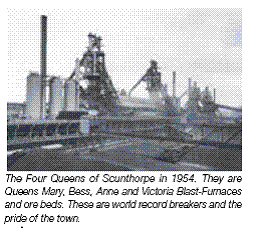
Field Visit to Scunthorpe and Crosby Warren Quarry - Saturday 25th March 2006
For the first trip of the 2006 season, our Field Trip Secretary Jane expressed the hope we would experience ‘Sunny Scunny’ but also reminded us that the wind, rain and snow on the east coast can be more severe than us softies living west of the Pennines are used to. Happily her wish came true and it was warm, dry and just a little sunny for the twelve of us who assembled outside the museum at Scunthorpe. We were met by Steve Thomas, Keeper of Earth Sciences who spoke to us about the geology of the area and how it has influenced the history and economy of the area.
Scunthorpe is situated in the middle of the Lower Jurassic which strikes north/south through Lincolnshire with Triassic to the west running through to Upper Cretaceous to the east at Grimsby. The strata are generally undeformed and flat lying and are predominantly limestones and mudstones deposited in a shallow sea with a land mass to the south east. The local stratigraphy is summarised below and is interpreted as representing deposition with varying amounts of clastic inputs from that landmass.
The iron is present as the carbonate Siderite and the clay mineral Chamosite in ooids and matrix material, not as nodules. Ironstones are not being deposited anywhere today and although it is generally accepted that a reducing environment is required to produce them, the mechanism of formation remains enigmatic. Total iron content is between 20-30% which might sound a lot but is at the lower end of what would be economically viable.
|
Lower Jurassic under Scunthorpe |
SYSTEM |
STAGE |
AGE |
|
|
U. Lias |
Toarcian |
178ma |
absent in N. Lincs |
|
|
|
Shales & mudstones |
|||
|
M. Lias |
Pliensbachian |
187Ma |
Marlstone above an unconformity |
|
|
|
Shales and mudstones |
|||
|
L. Lias |
|
Pecten Ironstone |
||
|
194Ma |
Marine silty mudstones |
|||
|
Sinemurian |
|
|||
|
|
Frodingham Ironstone c. 60’ thick |
|||
|
203Ma |
Shales & mudstones
|
|||
|
Hettangian |
|
|||
|
208Ma |
Limestones within mudstones |

**************************************